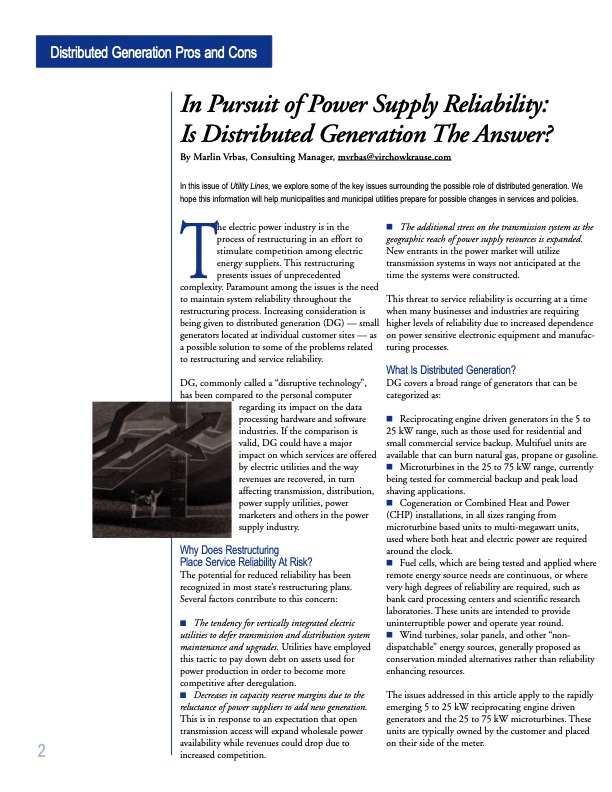
PDF Publication Title:
Text from PDF Page: 002
Distributed Generation Pros and Cons In Pursuit of Power Supply Reliability: Is Distributed Generation The Answer? By Marlin Vrbas, Consulting Manager, mvrbas@virchowkrause.com In this issue of Utility Lines, we explore some of the key issues surrounding the possible role of distributed generation. We hope this information will help municipalities and municipal utilities prepare for possible changes in services and policies. 2 The electric power industry is in the process of restructuring in an effort to stimulate competition among electric energy suppliers. This restructuring presents issues of unprecedented complexity. Paramount among the issues is the need to maintain system reliability throughout the restructuring process. Increasing consideration is being given to distributed generation (DG) — small generators located at individual customer sites — as a possible solution to some of the problems related to restructuring and service reliability. DG, commonly called a “disruptive technology”, has been compared to the personal computer regarding its impact on the data processing hardware and software industries. If the comparison is valid, DG could have a major impact on which services are offered by electric utilities and the way revenues are recovered, in turn affecting transmission, distribution, power supply utilities, power marketers and others in the power supply industry. Why Does Restructuring Place Service Reliability At Risk? The potential for reduced reliability has been recognized in most state’s restructuring plans. Several factors contribute to this concern: ■ The tendency for vertically integrated electric utilities to defer transmission and distribution system maintenance and upgrades. Utilities have employed this tactic to pay down debt on assets used for power production in order to become more competitive after deregulation. ■ Decreases in capacity reserve margins due to the reluctance of power suppliers to add new generation. This is in response to an expectation that open transmission access will expand wholesale power availability while revenues could drop due to increased competition. ■ The additional stress on the transmission system as the geographic reach of power supply resources is expanded. New entrants in the power market will utilize transmission systems in ways not anticipated at the time the systems were constructed. This threat to service reliability is occurring at a time when many businesses and industries are requiring higher levels of reliability due to increased dependence on power sensitive electronic equipment and manufac- turing processes. What Is Distributed Generation? DG covers a broad range of generators that can be categorized as: ■ Reciprocating engine driven generators in the 5 to 25 kW range, such as those used for residential and small commercial service backup. Multifuel units are available that can burn natural gas, propane or gasoline. ■ Microturbines in the 25 to 75 kW range, currently being tested for commercial backup and peak load shaving applications. ■ Cogeneration or Combined Heat and Power (CHP) installations, in all sizes ranging from microturbine based units to multi-megawatt units, used where both heat and electric power are required around the clock. ■ Fuel cells, which are being tested and applied where remote energy source needs are continuous, or where very high degrees of reliability are required, such as bank card processing centers and scientific research laboratories. These units are intended to provide uninterruptible power and operate year round. ■ Wind turbines, solar panels, and other “non- dispatchable” energy sources, generally proposed as conservation minded alternatives rather than reliability enhancing resources. The issues addressed in this article apply to the rapidly emerging 5 to 25 kW reciprocating engine driven generators and the 25 to 75 kW microturbines. These units are typically owned by the customer and placed on their side of the meter.PDF Image | Utility Lines Creating Advanced Telecommunications In Your Community: Where to Begin

PDF Search Title:
Utility Lines Creating Advanced Telecommunications In Your Community: Where to BeginOriginal File Name Searched:
biogas17.pdfDIY PDF Search: Google It | Yahoo | Bing
Capstone Turbine and Microturbine: Capstone microturbines used and new surplus for sale listing More Info
Consulting and Strategy Services: Need help with Capstone Turbine, sizing systems, applications, or renewable energy strategy, we are here to assist More Info
Container Lumber Dry Kiln: Since 1991 developing and innovating dry kilns using standard shipping containers More Info
Supercritical CO2 Lumber Dry Kiln: Compact fast drying in 3 days or less for small amounts of wood and lumber drying More Info
BitCoin Mining: Bitcoin Mining and Cryptocurrency... More Info
Publications: Capstone Turbine publications for microturbine and distributed energy More Info
FileMaker Software for Renewable Energy Developing database software for the renewable energy industry More Info
CO2 Gas to Liquids On-Demand Production Cart Developing a supercritical CO2 to alcohol on-demand production system (via Nafion reverse fuel cell) More Info
Stranded Gas for low cost power Bitcoin Mining Using stranded gas for generators may provide breakthrough low power costs for cryptocurrency miners. More Info
| CONTACT TEL: 608-238-6001 Email: greg@globalmicroturbine.com | RSS | AMP |